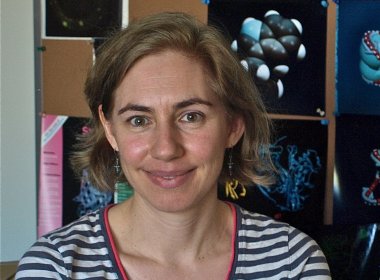EUGENE, Ore. -- (Sept. 18, 2012) -- The University of Oregon has received a five-year, $10.3 million grant from the National Institutes of Health (NIH) to launch a systems biology research and education center.
 The UO's Microbial Ecology and Theory of Animals Center for Systems Biology (META CSB) will be devoted to understanding how animal-associated microbial communities assemble, interact, evolve and influence human health and diseases. Funded by the NIH's National Institute of General Medical Sciences (NIGMS), the center will include 12 UO researchers from four institutes and four departments, said biology professor Karen Guillemin, who will head the facility.
The UO's Microbial Ecology and Theory of Animals Center for Systems Biology (META CSB) will be devoted to understanding how animal-associated microbial communities assemble, interact, evolve and influence human health and diseases. Funded by the NIH's National Institute of General Medical Sciences (NIGMS), the center will include 12 UO researchers from four institutes and four departments, said biology professor Karen Guillemin, who will head the facility.
"Every human is an ecosystem and is inhabited by microbial communities," said Guillemin, a researcher in the Institute of Molecular Biology, whose research has focused on bacterial activity in the gut. "As a group, we hope to develop new research tools and uncover revolutionary new information that will ultimately advance our knowledge of human illnesses that result from perturbed host-microbes interactions. Examples are inflammatory bowel diseases, diabetes, cancers and autoimmune-related disorders."
Systems biology is emerging as a powerful tool to test hypotheses relevant to health and disease, particularly therapeutic interventions. The META CSB is one of two newly funded systems biology centers announced by the NIGMS. The other new center is at the University of California, Berkeley. Two other existing centers received renewed funding.
"The University of Oregon META CSB is in a unique position to capitalize on the wealth of data scientists are generating about the human microbiome," said Shiva Singh, Ph.D., the NIGMS official who oversees the grant. "The center's novel tools and approaches will make important contributions to the development of new strategies for improving health and treating or preventing disease."
There are now 15 NIGMS-supported National Centers for Systems Biology in the United States. The centers promote pioneering research, research training, education and outreach programs focused on systems-level inquiries of biomedical phenomena within the NIGMS mission. The centers are expected to establish themselves as recognized leaders of research and education in systems biology.
"META CSB is the latest chapter in the UO's proud tradition of pioneering research that seeks to crack the genetic code of health and disease," said Kimberly Andrews Espy, vice president for research and innovation at the UO. "The center creates the foundation for a whole new field of host-microbe systems biology, and our researchers will be innovating tools, experimental approaches, best practices, analytical frameworks and conceptual models that promise to improve the health and well-being of people throughout the world."
The UO center's cross-disciplinary team will focus on the complex host-associated microbial communities and their interactions. Drawing from their own research and data available through the NIH-funded Human Microbiome Project, UO scientists will probe the assembly, dynamics and evolution of these microbial communities, using zebra fish and stickleback, both of which are used internationally as model organisms for studying human disease.
The UO pioneered the use of zebra fish in the 1970s under George Streisinger. Today, the UO-based Zebrafish International Resource Center, also funded primarily through the NIH, provides zebra fish embryos to more than 700 laboratories in 28 countries and maintains a comprehensive genetic database for researchers who use the fish.
Work at the new UO center will be done in four core areas: live imaging; gnotobiology (the study of organisms or conditions that are either free of microorganisms or associated only with known or specified microbes); genomics; and bioinformatics.
The center's team will include researchers from ecology, microbiology, molecular biology, biophysics, computer science and mathematics. Outreach, education and diversity missions are also key center activities, including partnerships with the University of Alaska to recruit Native Americans and Alaska natives into the field of systems biology.
Leaders of the center with Guillemin will be: Brendan Bohannan, biology and the Institute of Ecology and Evolution (IEE); John Conery, computer and information Science, IEE; William Cresko, biology, IEE; Judith Eisen, biology and the Institute of Neuroscience (ION); Jessica Green, biology, IEE; Eric Johnson, biology, IMB; David Levin, mathematics; Peter O’Day, neuroscience, ION; Raghuveer Parthasarathy, physics, Material Sciences Institute and IMB; Patrick Phillips, biology, IEE; and John Postlethwait, biology, ION.
Funding for the new UO center comes from the NIH as grant number P50 GM098911.
About the University of Oregon
The University of Oregon is among the 108 institutions chosen from 4,633 U.S. universities for top-tier designation of "Very High Research Activity" in the 2010 Carnegie Classification of Institutions of Higher Education. The UO also is one of two Pacific Northwest members of the Association of American Universities.
Media Contacts: Jim Barlow, director of science and research communications, 541-346-3481, jebarlow@uoregon.edu, and Lewis Taylor, associate director of communications, Office of Research, Innovation and Graduate Education, 541-346-2816, lewist@uoregon.edu
Source: Karen Guillemin, associate professor of biology, 541-346-5360, kguillem@uoregon.edu
Follow UO Science on Facebook: http://www.facebook.com/UniversityOfOregonScience
Note: The University of Oregon is equipped with an on-campus television studio with satellite uplink capacity, and a radio studio with an ISDN phone line for broadcast-quality radio interviews. Call the Media Contact above to begin the process.
###